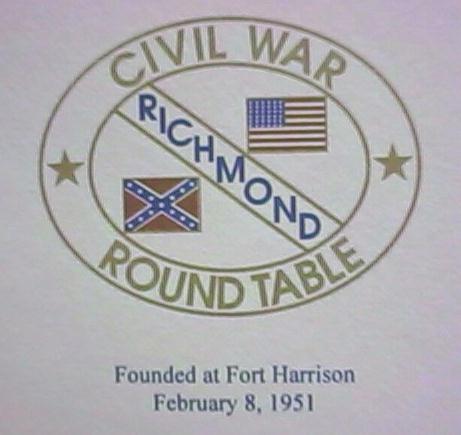


June 2004
rcwrt.org
First Vice President: Rob Monroe, Editor Richard Forrester 2416 Edenbrook Dr. Second Vice President: Richmond, VA 23228-3040 Shep Parsons rmonroe@richmond.com
June 2004 PROGRAM Mr. Gary Ecelbarger "The Bridge Blunder Before the Battle: Investigating the Shields-Carroll Controversy at Port Republic" 8:00 p.m., Tuesday, June 8, 2004, at the Boulevard United Methodist Church, 321 N. Boulevard, Richmond, VA (corner of Boulevard and Stuart Ave.) Enter the basement door on the right side under the front steps. "The whole affair has been a stupendous blunder," groaned an Indiana captain in Shield's division a few days after the Battle of Port Republic. Another Hoosier officer redundantly ranted, "The responsible general should have his head decapitated." The ire of the combat soldiers flew in two directions. Brig. Gen. James Shields and Col. Samuel Sprigg Carroll took the brunt of the criticism for their decisions in the action of June 8-9, 1862, where more than 1,000 U.S. soldiers were killed, wounded and captured in and near the Shenandoah Valley town of Port Republic. The commanders fueled the fire by pointing accusing fingers at each other. Did Gen. Shields order Col. Carroll to save the bridge over the North River or to burn it on June 8, 1862? "History, so far as I know, has failed to tell who was responsible for that great blunder," insisted a participant of the action. "There are volumes of unwritten history stored in the minds of our comrades that should be given to the public before they are forever sealed." Newly discovered documents at the National Archives force a reinvestigation of this issue. Red-stamped with "Copied, War Records, 1861-1865," but never published, these overlooked gems provide precious insight into Union command decisions in the Shenandoah Valley in June of 1862. When these documents are spliced into a chronological timeline along with other archival and published dispatches and letters, the resulting paper trail leads to a revised interpretation of the events leading up to the Battle of Port Republic. On June 8, 2004, Gary Ecelbarger will commemorate the 142nd anniversary of the Port Republic bridge incident by sharing the new information in a provocative presentation to the Richmond Civil War Round Table. Gary Ecelbarger is a tour guide for the Civil War Education Association and the author of two books (We Are In For It: The First Battle of Kernstown and Frederick W. Lander: The Great Natural American Soldier), two contributed works, and a dozen articles about Civil War personalities and events. He is a charter member and board member of the Kernstown Battlefield Association, an organization that has successfully salvaged 315 acres of the 1st and 2nd Kernstown Battlefields and converted them into an interpretive park. He is currently writing a biography of John "Black Jack" Logan.
Review of the May Program
 |
JUNE EVENTS June 12 - Richmond Battlefields Association annual meeting at Willis Methodist Church on the Frayser's Farm/Glendale battlefield. Walking tour at 10:00am includes the privately owned Whitlock Farm in the heart of the battlefield. Free, open to RBA members and non-members alike. More info: www.saverichmondbattlefields.org. June 19-20 - Medical Living History at Exchange Hotel and Civil War Medical Museum in Gordonsville. Surgical and medical demonstrations in a real Civil War hospital. More info: 540-832-2944 or www.hgiexchange.org. June 25-27 -- Conference on Women and the Civil War sponsored by the Society for Women and the Civil War and the Museum of the Confederacy. Lectures, bus tour and the premier of a documentary on the life and adventures of Sarah Emma Edmonds, alias Pvt. Franklin Thompson. More info: 540-381-4518 or womenandthecivilwar.org or womencivilwar@aol.com. June 26-27 - 1860 Summer Extravaganza at Pamplin Historical Park and the National Museum of the Civil War Soldier. Family event recreating an old time country fair. Music, dancing, games, cooking and horse racing. More info: www.pamplinpark.org or 1-877-PAMPLIN
Last Civil War Widow Dies A 97-year-old Alabama woman, the last widow of a Civil War veteran, died on Memorial Day of complications from a heart attack she suffered May 7. Alberta Stewart was a 21-year-old poor single mother when she met 81-year-old William Jasper Martin, a widower collecting a $50-a-month pension for his service in the 4th Alabama Infantry. Their 1927 wedding was a marriage of convenience if not necessity for Alberta. Ten months later, they had a son. Two months after William Jasper Martin's death in 1931, Alberta married his grandson. William Jasper Martin rarely mentioned the war to Alberta, though she recalled him telling her of the hardships he endured during the siege of Petersburg. In 1996, Mrs. Martin was awarded Confederate widow's benefits by the state of Alabama.
RCWRT Monthly Speakers for 2004
Newsletter Deadlines To facilitate the printing and timely distribution of the monthly newsletter, information for it should be submitted to the editors no later than the following dates: June newsletter May 28 July newsletter July 2 August newsletter July 30 September newsletter September 3 October newsletter October 1 November newsletter October 29 December newsletter December 3 Information may be emailed to rmonroe@richmond.com
Richmond Civil War Round Table Newsletter Rob Monroe, Editor 2416 Edenbrook Dr. Richmond, VA 23228-3040
Return to News Letters Index
Return to main page

©R.C.W.R.T. 2004